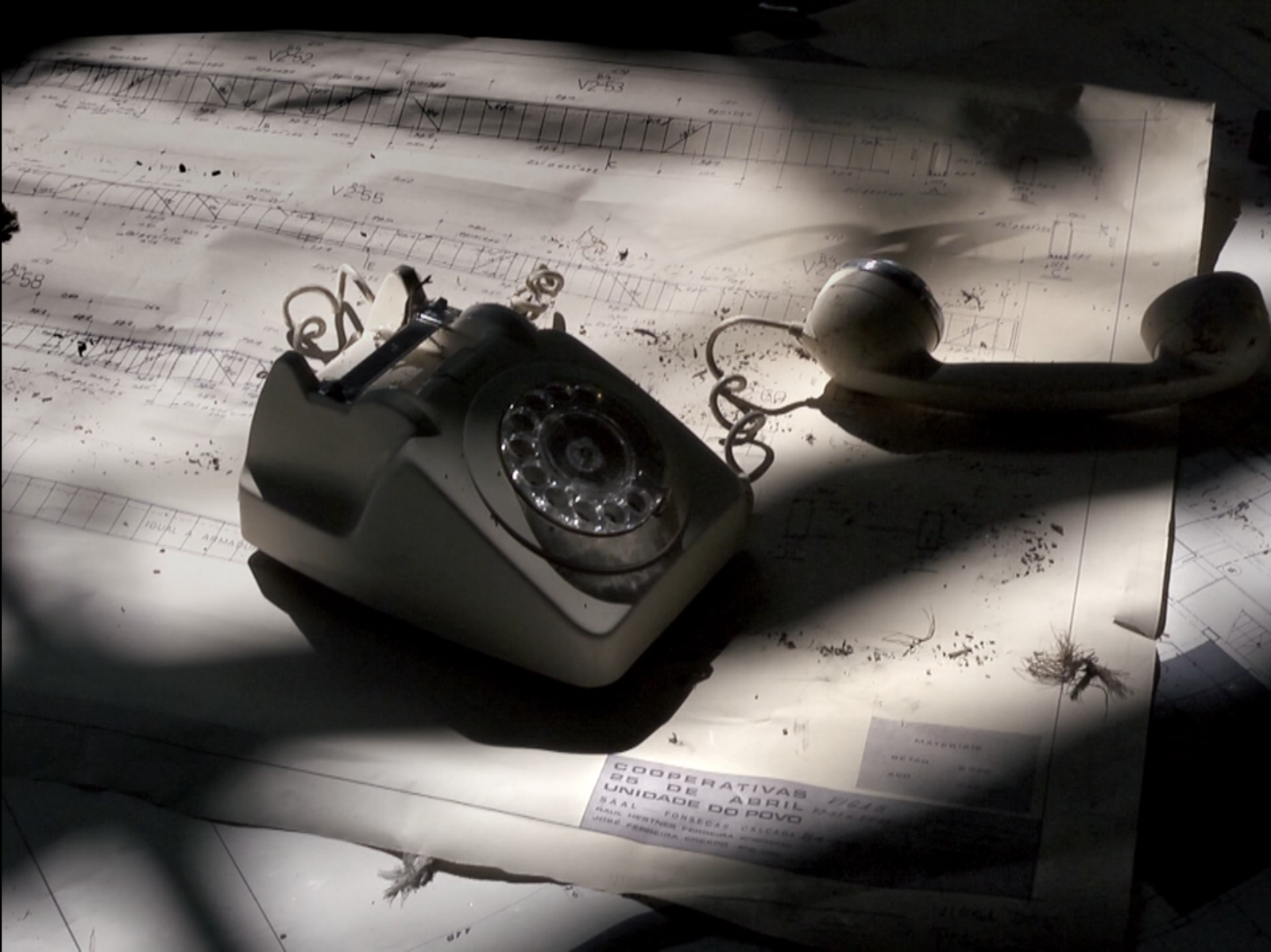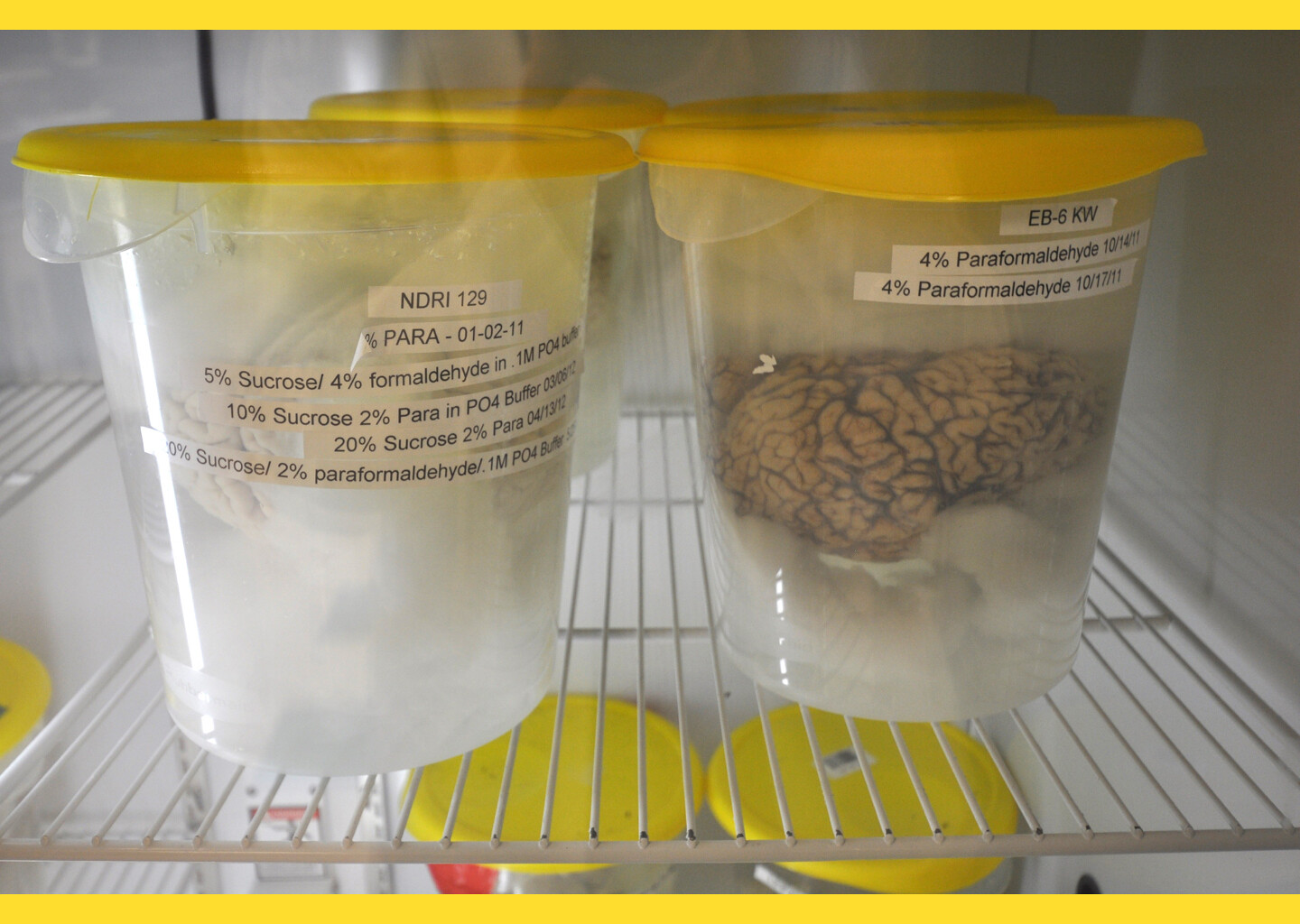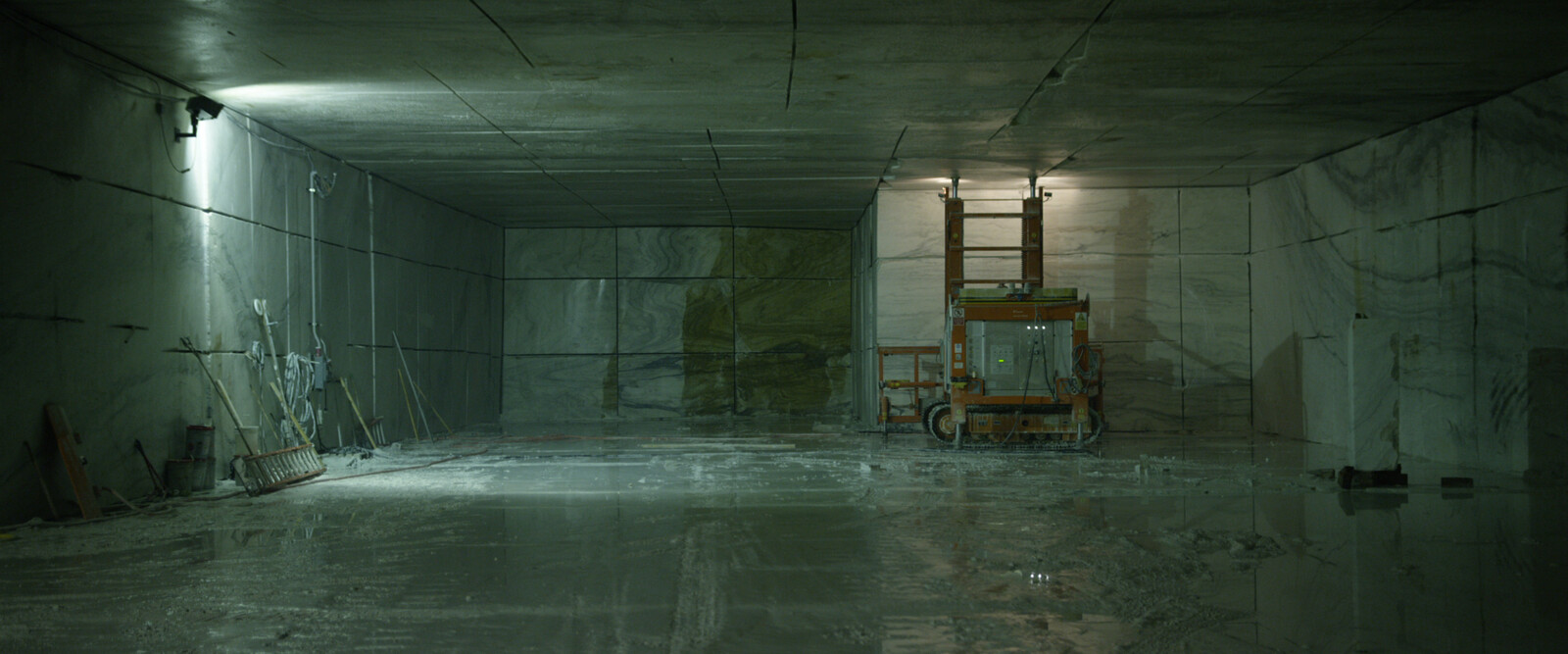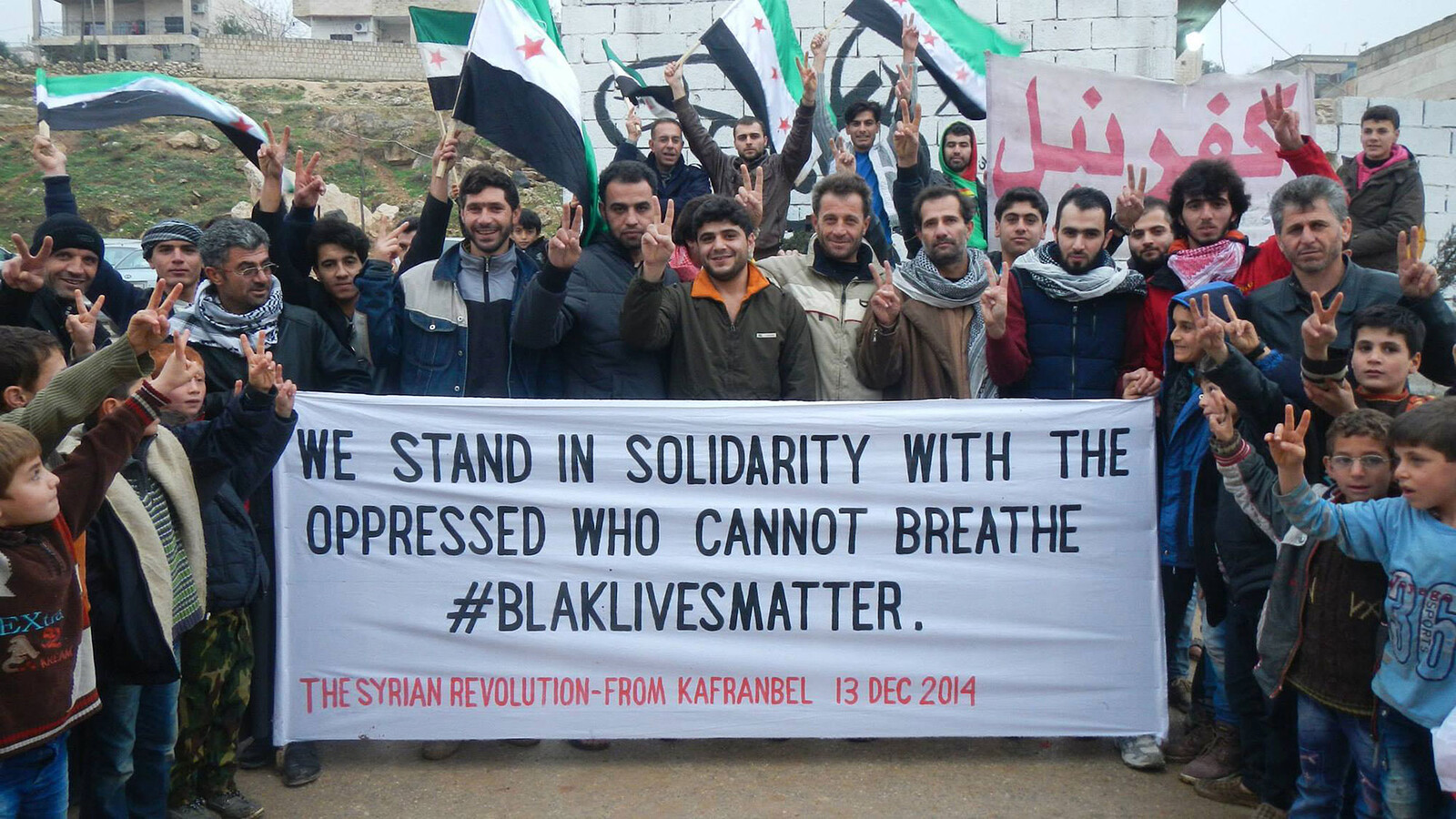Pale light could be seen coming from gaps in a large, low building. A simple clarity had been disturbed. True size was hard to read. The function of this place was hard to define. The surrounding landscape held no markers or signs. Nothing stood close by in order to provide scale. The mass refused to reveal itself. Cuts in the facade were troubling and extreme. Great tears and raw holes had broken through a thin metal skin, yet the basic framework remained. A view through the cuts revealed people moving inside, slow and withdrawn, methodically dismantling. There were neat piles of machine parts, stacks of piping and conduit, barrels of coolant, lubricant and machine oil, piles of metal, concrete and wood. People stuck to the edges, leaving a clear space in the center, where low seating had been improvised along with large tables and slung lighting. Surrounding this area, large screens had been constructed from partition walls ripped from their original place. Upon these screens many hands had created a woven mass of text, notation, plans and calculations.
For the people in this building, there was some regret that an early fire had been fueled by instruction manuals, technical journals, machine-part plans and employment records. It seemed like a good idea at the time, and had kept the cold at bay, but if they had kept these documents they would have been able to remember a great deal more. They used to work in teams, but now they start each day in large, disorganized groups. This was never very effective for long, as shabby masses ended up following each other around in the gloom. It only takes a few minutes before people peel away and wander off to work alone. Each vie to win space on a screen by creating their own deconstruction of previous working methods, where they can silently inscribe their work. An accounting for everything, punctuated by the sound of improvised tools tearing at the few remaining interior walls and stubborn structures that once held large machines and production lines.


Still from the Mexican comedy by Joaquin Del Paso, Maquinaria Panamericana (2016).
Not many people were actually active, and those who were sometimes just stopped what they were doing. Many just stood around all day, while others laid on the floor or slumped in the shadows. There was no sense of organization here. Some people held onto pieces of old machinery that they used to slowly tear at the walls. Some were more effective than others. Some repeatedly bent and folded the torn metal edges over and over again in an attempt to pull it free, hacking new gaps into the exterior. The jagged folds cut into skin.
There were no clear aims at the outset, merely a desire to return and occupy a former place of work. In the old days, everyone had been well looked after. The collective memory and potential of this place was appealing. Yet no one could remember exactly why they had returned, or when they stopped leaving at night. At first they just hung around and talked about why things had gone so wrong. After a while they started to draw out neat new openings on the walls, which would make fine new windows once the factory reopened. The dismantling of machinery only came once people had stopped going home in the evenings. Anyone passing by would hear the sound of work late into the night, which would make them happy to think that things were being made, that jobs had returned. The sound of action was calming and reassuring.
In the beginning, the factory was quiet only for a few short hours early each morning, when some of those working through the night left to bring back food. After a while no one ever left. Instead, a barely-sustaining supply of root vegetables was grown in small gardens close to the holes in the walls. Water was sourced from a hand pump in one of the building’s corner. And that was it. Due to the weakness of light and the endless cold, a great deal of time and care was put into the gardens. Neither enough to feed everyone properly nor to distract from the primary activity. All sustaining effort went into careful destruction and calculation; every available surface was marked, every table covered in diagrams. There were lists of materials and lists of processes. There were potential shipping routes and estimated production times. As the former factory was dismantled, a new virtual production line took its place; a production line that was not limited by their imaginations, and not restricted to one location. Their calculations were boundless, factoring in all zones of production on earth. They were calculating all relations of production, in the cold, in the gloom, in an abandoned factory in the snow.
A complex, yet inaccurate form of Comparative Statics had become a common language, led by both the desire to account for everything and the need to create a new series of equations that could rebalance relations between objects and objects as well as objects and people. They wanted to quantify all relationships; everything should be tied to everything else in a desperate search for balance. This was inverse productivity. The machinery had been broken back down into its component parts. In one area of the building, attempts were being made to reduce those parts to their most elemental form. This was not recycling towards the production of new things, but a returning to the earth. This reverse production was slow; the inverse of the extremes of capitalism’s early dynamic.
The group worked on their project with slow determination, stopping at any time, without warning, to refine their calculations on the nearest available surface. There was an increasing sense that a certain understanding was being reached, a certain level of resolution being achieved. The boundaries of the building were now completely porous. Interior gardens extended through gaps onto the hard landscape outside. Increasingly large and carefully differentiated piles of materials were lumped just outside the factory walls, awaiting their return to earth. There had been a point when some children were born and some people died, but children stopped being born and no one noticed death any longer. A large number of people were maimed in accidents and did what they could to continue without complaint. The old worked alongside the young. There was no obligation to do anything beyond pursue the common drive to create an economy of equivalence. The texts and calculations formed an enormous archive inscribed on a devastated place. The markings comprised a massive log of all potential exchanges. They were an exhausted group, creating a perfect model of exchange. This was a project derived from experience; a complete dismantling.
Over time the building no longer resembled a factory or anything precise. It had begun to become absorbed into the landscape. The simple rigor of the original structure had been lost. Any remaining surface was dented and bent. The roof was missing in places. At night people just dropped to the floor wherever they found themselves and went to sleep. In good weather they slept in the main hall on platforms suspended above the floor so they could survey their work when they awoke. The few remaining walls and improvised screens were so heavily marked with calculations that they provided a reassuring backdrop and soft stimulation for the brain. The younger people had no real understanding of what this work had been for, but it was work, and it was going to work. Special days emerged over time, markers in the history of this place: celebrating moments when ores and fuels had been restored to the ground; celebrating the harvest of their starchy pale food. There was a feeling that all relationships in the world would be accounted for at some point.
The rate of work taking place was hard to gauge. Most of the time the building was silent and nothing could be heard. Nothing moved. The people didn’t move. Yet in their minds, they were still resolving all great material relationships; breaking down structures and accounting for everything. New standards had emerged, connected to an ability to resolve rather than construct. Any attempt to provide an objective reading of this work was bound to fail. The last agonized efforts went into gardening, and even that was barely maintained. Yet there was still a sense that this was a better way. Free from the constraints of production and even the obligation to improvise. A true parallel had been created in their heads; a political economy of the mind that offered a true illusion of important work.
One winter, as the weather grew even colder, three new people arrived. They claimed to have come from a similar place, yet nobody still lived who could verify their claim. Their story sounded real enough, and their experiences extremely familiar. They too had been part of an improvised community, a long way from here. Soon after their arrival, even the most languid attempts at work stopped. Many nights were now spent silently comparing research with the new arrivals. The factory space was cleaned up a little. Gardening stopped.
The idea of killing animals had never occurred to the factory people, but cooked meat lifted many from the floor who now eagerly joined in a thorough process of reconstruction. Some talked, weakly pointing out their work. Parts of the former walls had to be restored in order to show how things were deconstructed in the first place. A small generator was coaxed back into life to provide more light to see their calculations. It was necessary to show the visitors how the resolution of all material relationships had been achieved. Layers of text were carefully cleaned from the walls, each removal revealing a hidden logic beneath. The walls were transcribed onto paper, which were carefully stacked, bound and archived. Imperfectly collated indexes were produced. The visitors could sometimes be found searching through the shadows. Initially this was of no concern. There were suspicions, yet few could find any true focus for their worries. Work began on the reconstruction of a computer-controlled welding machine, just to show what it had been made of. This labor took a terrible toll. Completed, it joined a paint shop that had been completed a few weeks earlier to make a point. One exterior wall of the former factory had been restored to demonstrate its deconstruction. This effort finished some people off, and others were terminally diminished. But the collective desire to show off their insights led to renewed efforts. A new, simple, high fat and high carbohydrate diet was introduced, leaving everyone a little bloated for a while. Some saw their weight increase, but others were too weak to cope with the sudden change in diet. The mere pressure of reconstruction finished off many more. People were now encouraged to account for their work, and show how productive they had been in their explanations and their reconstructions. Complex relationships were forgotten. Everything now had a rational aim. Death was increasingly common as the rate of work increased and new strains took hold. The rate of reconstruction increased. More people died. Everything was being explained in reverse. And more people died on their feet.
The three new arrivals surveyed the space. They were happy with the reinstated plant; clean and clear, efficiently manned and devoid of marks and complexity. The remaining workers spent their last night at their new control stations staring into screens. A large smelter stood close by, heating iron ore ready for production. As the last gap in the exterior of the building was being closed, they stood as one and mounted the smelter gantry. They stood together in a line looking down into the first batch of molten metal being readied for the production line. Without glancing or speaking, they moved forward together, stepping briefly into a searing wave of uplifting heat before dropping fast and sinking silently into the melt.
Superhumanity is a project by e-flux Architecture at the 3rd Istanbul Design Biennial, produced in cooperation with the Istanbul Design Biennial, the National Museum of Modern and Contemporary Art, Korea, the Govett-Brewster Art Gallery, New Zealand, and the Ernst Schering Foundation.
Superhumanity, a project by e-flux Architecture at the 3rd Istanbul Design Biennial, is produced in cooperation with the Istanbul Design Biennial, the National Museum of Modern and Contemporary Art, Korea, the Govett-Brewster Art Gallery, New Zealand, and the Ernst Schering Foundation.
































































